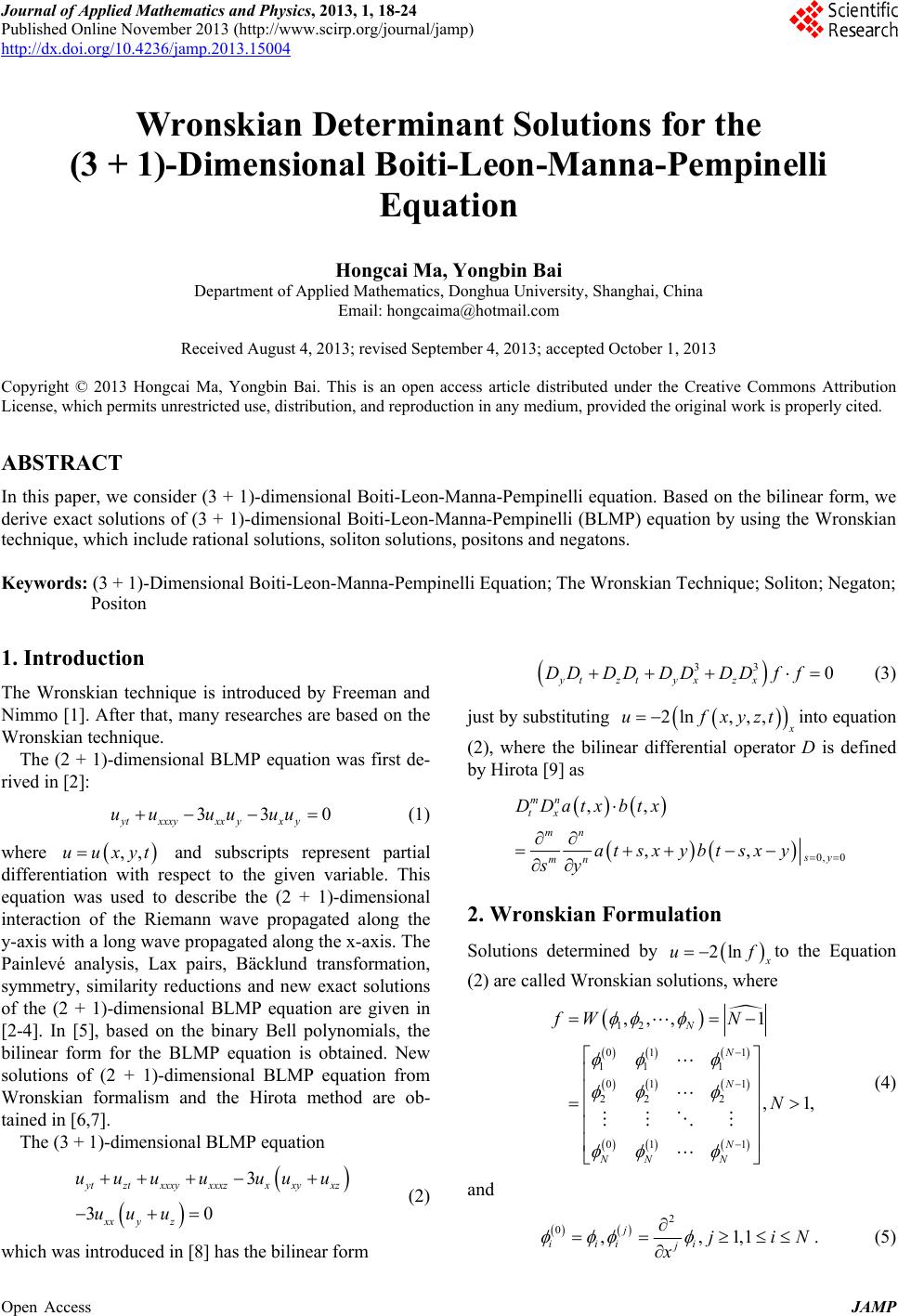 Journal of Applied Mathematics and Physics, 2013, 1, 18-24 Published Online November 2013 (http://www.scirp.org/journal/jamp) http://dx.doi.org/10.4236/jamp.2013.15004 Open Access JAMP Wronskian Determinant Solutions for the (3 + 1)-Dimensional Boiti-Leon-Manna-Pempinelli Equation Hongcai Ma, Yongbin Bai Department of Applied Mathematics, Donghua University, Shanghai, China Email: hongcaima@hotmail.com Received August 4, 2013; revised September 4, 2013; accepted October 1, 2013 Copyright © 2013 Hongcai Ma, Yongbin Bai. This is an open access article distributed under the Creative Commons Attribution License, which permits unrestricted use, distribution, and reproduction in any medium, provided the original work is properly cited. ABSTRACT In this paper, we consider (3 + 1)-dimensional Boiti-Leon-Manna-Pempinelli equ ation. Based on the bilinear form, we derive exact solutions of (3 + 1)-dimensional Boiti-Leon-Manna-Pempinelli (BLMP) equation b y using the Wronskian technique, which include rational solutions, soliton solutions, positons and negatons. Keywords: (3 + 1)-Dimensional Boiti-Leon-Manna-Pempinelli Equ ation; The Wronskian Technique; Soliton; Negaton; Positon 1. Introduction The Wronskian technique is introduced by Freeman and Nimmo [1]. After that, many researches are based on the Wronskian technique. The (2 + 1)-dimensional BLMP equation was first de- rived in [2]: 33 ytxxxyxx yx y uuuu uu 0 (1) where and subscripts represent partial differentiation with respect to the given variable. This equation was used to describe the (2 + 1)-dimensional interaction of the Riemann wave propagated along the y-axis with a long wave propaga ted along the x-ax is. The Painlevé analysis, Lax pairs, Bäcklund transformation, symmetry, similarity reductions and new exact solutions of the (2 + 1)-dimensional BLMP equation are given in [2-4]. In [5], based on the binary Bell polynomials, the bilinear form for the BLMP equation is obtained. New solutions of (2 + 1)-dimensional BLMP equation from Wronskian formalism and the Hirota method are ob- tained in [6,7]. ,,uuxyt The (3 + 1)-dimensional BLMP equation 3 30 t ztxxxy xxxzxxy xz xx yz uuuuuuu uu u (2) which was introduced in [8] has the bilinear form 33 0 yt ztyxzx DDDDDDDDf f (3) just by substituting 2ln, ,, ufxyz tinto equation (2), where the bilinear differential operator D is defined by Hirota [9] as 0, 0 ,, ,, mn tx mn sy mn DDatx btx at sxybt sx y sy 2. Wronskian Formulation Solutions determined by 2ln u f to the Equation (2) are called Wronskian solutions, where 12 01 1 11 1 01 1 22 2 01 1 ,,, 1 ,1 N N N N NN N fW N N , (4) and 2 0,,1,1 j iii i jji x N . (5) 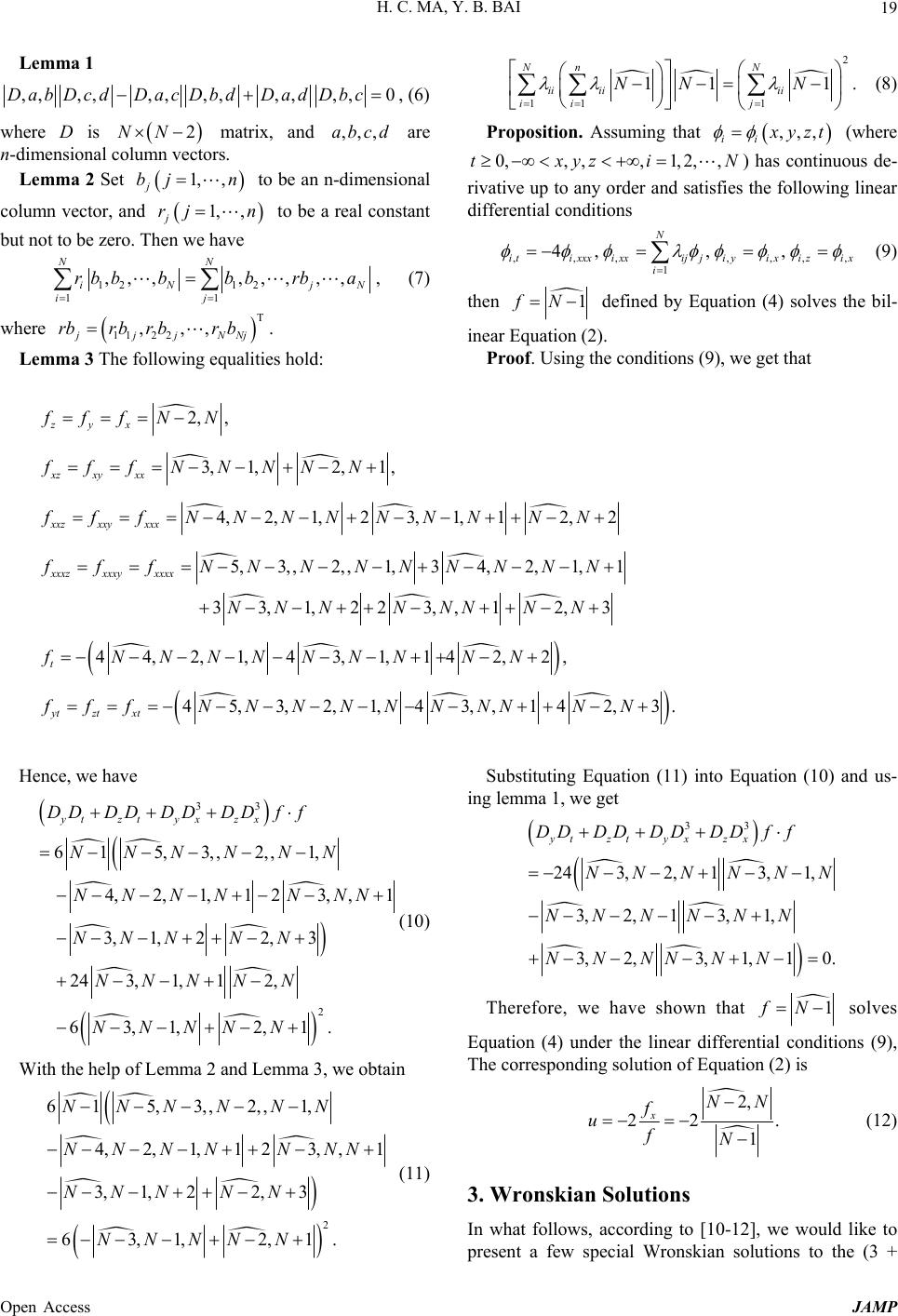 H. C. MA, Y. B. BAI 19 Lemma 1 ,,,,,,,,,,,, 0DabDcdDacDbdDad Dbc , (6) w matrix, and are n-dimensional columors. -dimensiona real consta bu hen we have here D is 2NN n vect,,,abcd Lemma 2 Set to be an nl column vector, and 1, , j rj n to be ant 1, , j bj n t not to be zero. T 12 ,,,, ,, NN i jN rbbrba , (7) 12 ,, N b bb where Lemma 3 The following equalities hold: 11 ij T 112 2 ,,, jjjNNj rbrbr brb. 2 11 1 11 1 Nn N ii iiii ii j NN N . (8) Proposition. Assuming that ,,, ii yzt ,N (where ) has continuous de- 0,, ,,1,2,txyzi rivative up to any order and satisfies the following linear differential conditions ,,, ,,, 1 4,,, N itixxxixxijjiyixizix i, (9) then 1fN defined by Equation (4) solves the bil- inear Equation (2). Proof. Using the conditions (9), we get that 2, , zyx ffNN 3,1,2,1, xz xy xx fffNNNNN 4,2, 1,23, 1, 12,2 xxz xxyxxx f ffNNNNNNNNN 5,3,,2,, 1,34,2, 1, 1 33,1,223,,1 2,3 xxxz xxxy xxxx fffNN NNNNNNN NNNNNN NN 44,2,1,43,1,142,2 t fNNNNNNN NN , 45,3,2,1,43,,142,3 yt zt xt fff NNNNNNNN.N Hence, we have N 33 2 5,3,,2,,1, 4,2,1,123,,1 3, 1,22,3 243, 1, 12, 63,1,2,1. yt zt yx zx DD DD DDDDff NNNN NNNN NNN NNNNN NNNNN NNNNN (10) With the help of Lemma 2 and Lemma 3, we obtain 61NN 2 61 5,3,,2,,1, 4,2,1,1 23,,1 3, 1,22,3 63,1, 2,1. NNNN NN NNNN NNN NNNNN NNNNN (11) Substituting Equation (11) into Equation (10) and us- ing lemma 1, we get 33 243,2, 13,1, 3,2, 13,1, 3,2,3,1,1 0. yt ztyxzx DD DD DDDDff NNNNNN NNNNNN NNNNNN 1fN Therefore, we have shown that solves lution of Equation (2) is Equation (4) under the linear differential conditions (9), The corresponding so 2, 221 xNN f ufN . (12) 3. Wronskian Solutions In what follows, according to [10-12], we would like to present a few special Wronskian solutions to the (3 + Open Access JAMP 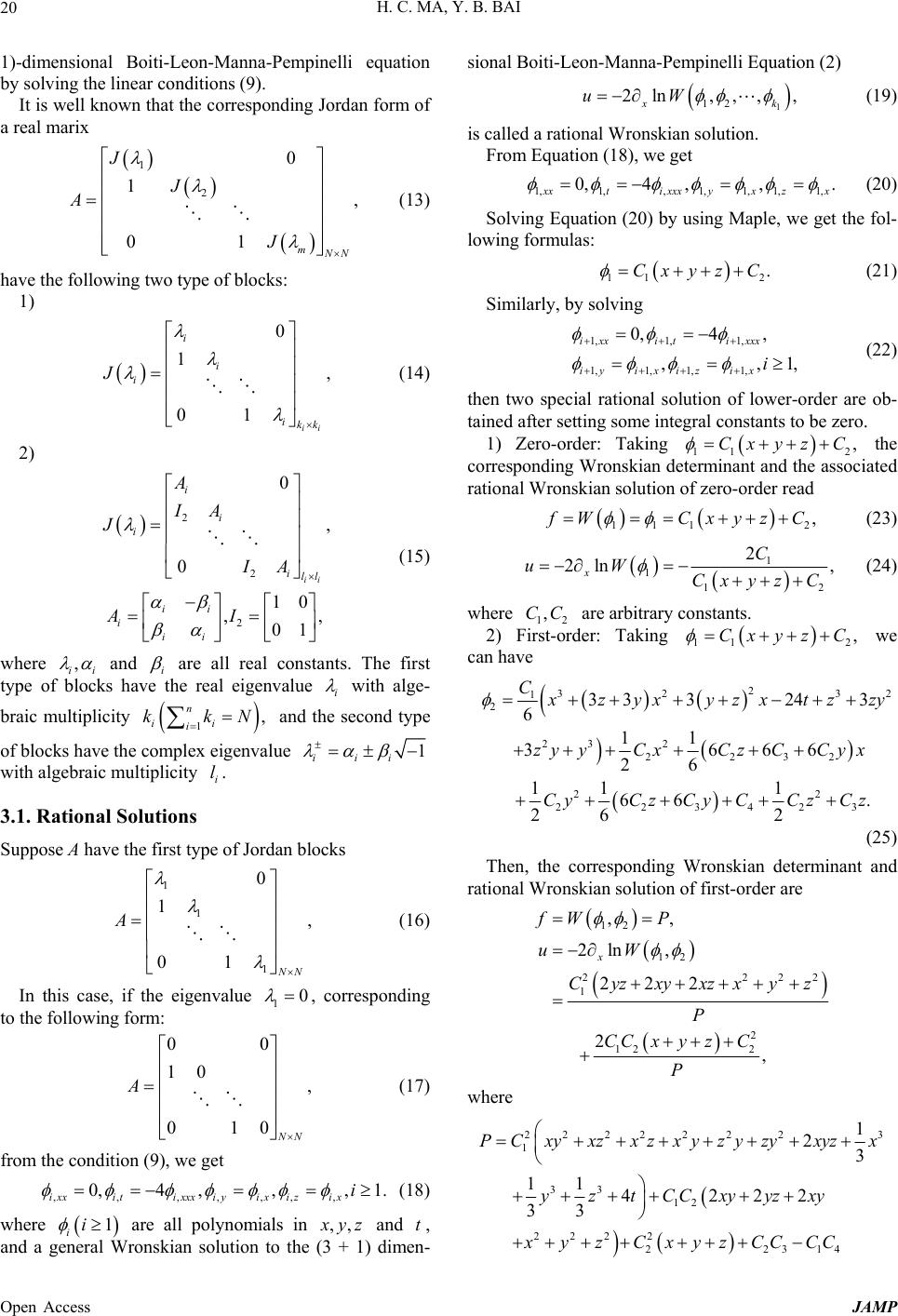 H. C. MA, Y. B. BAI 20 1) pinelli by-dimensional Boiti-Leon-Manna-Pemequation solving the linear conditions (9). It is well known that the correspond ing Jordan form of a real marix 1 2 0 1, 1 m 0 N J J A J (13) 2) (15) where have the following two type of blocks: 1) , i J (14) 0 1 i i 01 ii ikk 2 2 2 0 , 10 ,, 01 ii i i i ill ii iii A IA J AI 0IA , ii and i have thare all real constants type of e real eigenvalue. The first blocks i with alge- braic multiplicity and the second type of blocks have the complex eigenvalue 1, n ii i kkN 1 iii with algebraic multiplicity 3.1. Rational Solutions Suppose A have the first type of Jordan blocks i l. 1 1 1 0 1, 01 N A (16) the eigenvalue In this case, if 10 , corresponding to the following form: 00 10 , 010 N A (17) from th e condition ( 9), we get ,,,,,, 0,4 ,, ixxitixxxiy ixiz, , 1. ix i (18) where are all polynomials in 1 ii ,, yz (3 + 1) and and onskian solution to the dim si (19) is called a rational Wronskian solution. From Equation (18), we get t, en-a general Wr onal Boiti-Leon-Manna-Pempinelli Equation (2) 2u 1 12 ln,,,, xk W 1,1,,1,1,1,1, 0,4 ,,. xti xxxyxzx (20) ing Maple, we get the fol- Solving Equation (20) by us lowing formulas: .Cxyz C 11 2 Similarly, by solving 1,1, 1, 0,4 , i xxiti xxx 1, (21) 1,1,1,1, ,, iy ixiz ix i (22) -order are ob- o be zero. 1) Zero-order: Taking corresponding Wronskian dete ra then two special rational solution of lower ta l constants tined after setting some integra 11 Cxyz C rminant and the as2 , the sociated tional Wronskian solution of zero-order read 111 2 , WCxyz C (23) 1 1 2l n x uW 12 2, C Cxyz C (24) where are arbitrary constants. 2) der: Taking 12 ,CC First-or 11 2 ,Cxy z C we can have 2 32 3 133 3243 C 2 2 22 223423 11 1 66 26 2 2 23 2 223 611 36 66 26 . zyxyzx tz zy zy yCxCzCCyx Cy CzCy CCz Then, the corresponding Wronskian determinant and Wroner are Cz (25) rationalskian solution of first-ord 12 12 22 1 2 12 2 ,,fW P 22 2l n , 222 2, x uW Cy zxyxzxyz P CC xy zC P where 22 222223 11 2PCxyxzxz xyzy zyxyzx 33 12 22 2 2 22314 3 114222 33 yztCCxyyzxy xyzCxyzCCCC Open Access JAMP 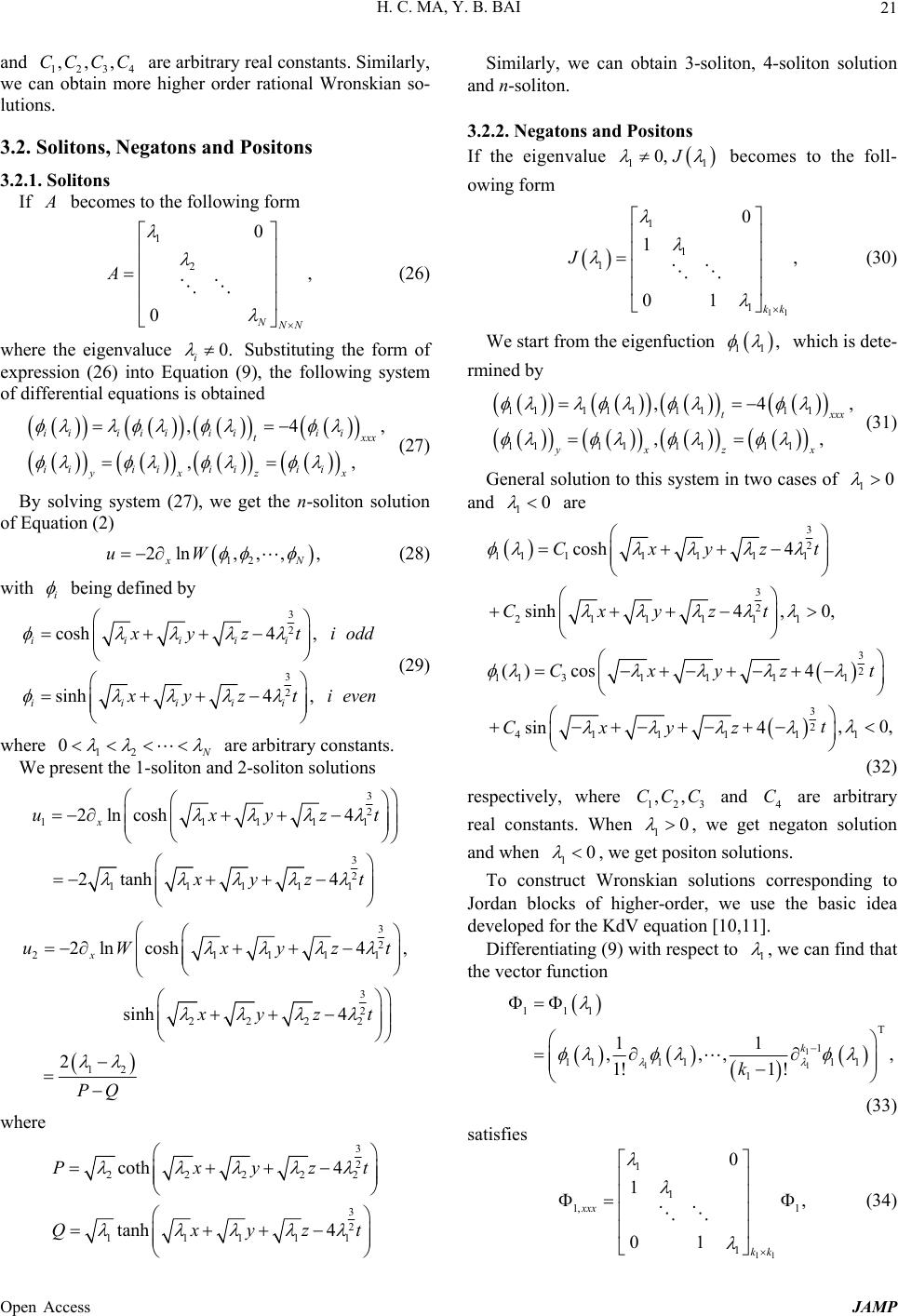 H. C. MA, Y. B. BAI 21 and are arbitrary real constants. Similarly, e higher order rational Wronskian so- lutions. 3.2. Solitons, Negatons and Positons 3.2.1. Solitons If 1234 ,,,CCCC we can obtain mor becomes to the following form 1 2 0 , 0N N A (26) where the eigenvaluce 0. i nSubstituting the form of expression (26) into Equatio (9), the following system of differential equations is obtained ,4, iiiiiiiii t xxx i (27) ,, iii iiii yxzx By solving system (27), we get the n-soliton solution (28) with of Equation (2) 12 2ln,,, xN uW , i being defined by 3 2 3 2 cosh4 , sinh4, ii iii iiiii yztiodd y (29) zti even where 12 0 are arbitrary constants. We and 2-soliton solutions present the 1-soliton 3 2 11111 2 1111 2lncosh4 anh 4 x uxyzt xyzt 3 1 2t 3 2 2 2ln cosh x uW 1 111 3 2 2222 12 4 , sinh 4 2 xyzt xyzt PQ w here 3 2 2222 3 2 11111 coth 4 tanh 4 Pxyz Qxyz 2 t t Similarly, we can obtain 3-soliton, 4-soliton solution and n-soliton. 3.2.2. Negatons and Positons If the eigenvalue 11 0, J becomes to the foll- owing form (30) We start from the eigenfuction 11 1 1 1 1 0 1, 01 kk J 11 , which is dete- rmined by 11111 1111 1111 1111 ,4 ,, tx yxzx , xx (31) General solution to this system in two cases of 10 are and 10 3 2 11 11111 cosh 4Cxyzt 3 2 3 2 31 111 3 4111 4, 0, cos 4 sin 4 zt xyzt Cxyz 21 11 sinhCx y 11 11 ()C 2 11 , 0,t (32) respectively, where and are arbitrary re 123 ,,CCC 4 C al constants. When 10 , wegaton solution get ne and when 10 , we solu To construct Wronskian solutions corresponding to Jordan blocks of higher-order, we use the basic developed for the KdV equation [10,11]. get positon tions. idea Differentiating (9) with respect to 1 , we can findt the vector function tha 1 11 111 T 1 11 1111 1 11 ,,, 1!1 ! k k , (33 satisfies ) 11 1 1 1, 1 1 0 1, 01 xxx kk (34) Open Access JAMP 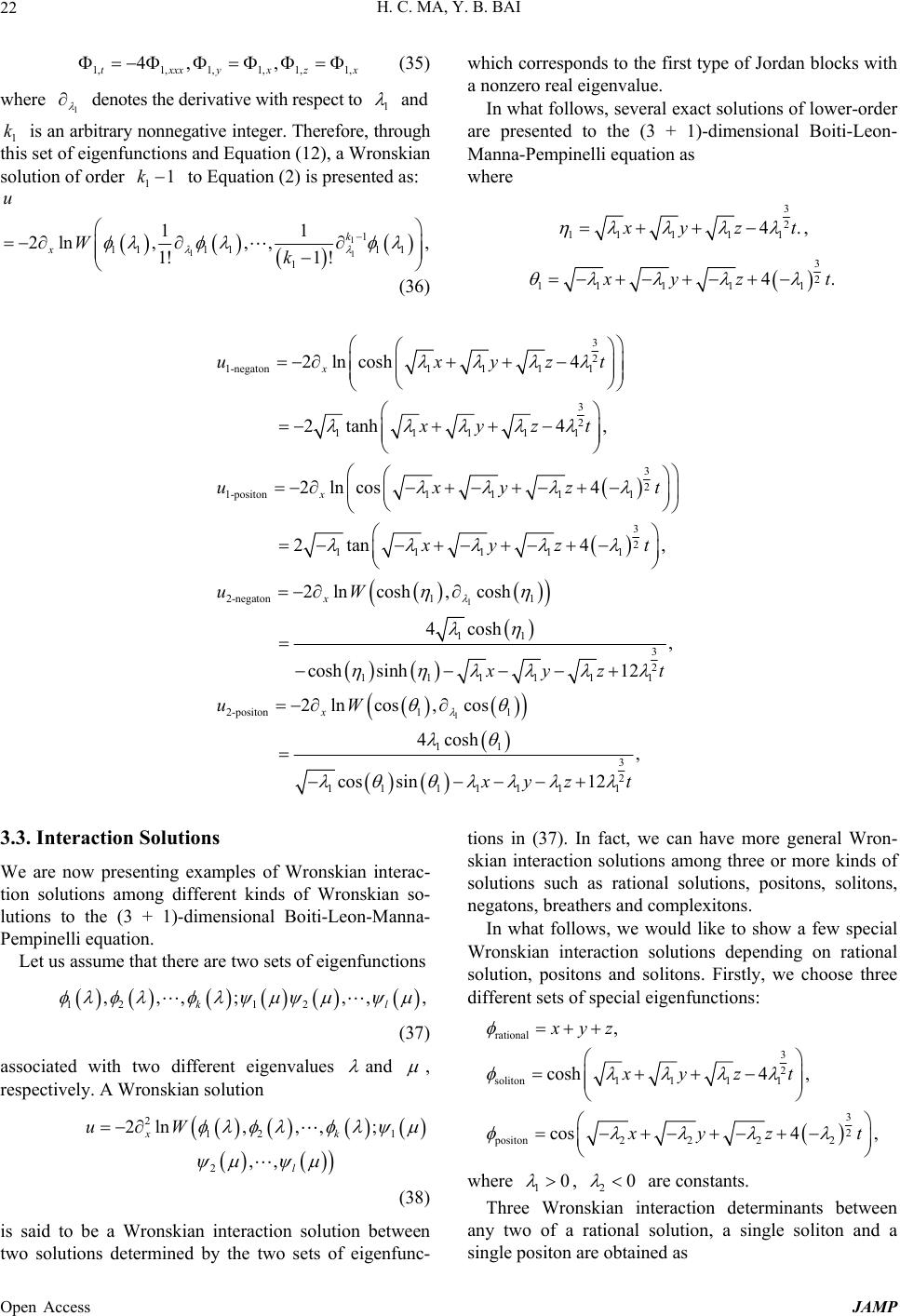 H. C. MA, Y. B. BAI Open Access JAMP 22 1, 1,1,1, 4 , txx (35) where 1 1, 1, , xxxy z denotes the tive with respect to 1 deriva and k is an ar nonnegative integer. There 1bitraryfore, through this set of eigenfunctions and Equation (12), a Wronskian solution of order 11k to Equation (2) is presented as: 1 11 1 1111 2ln xW 11 11 1 , ,,, 1!1! k k (36) orr a n where which cesponds to the first type of Jordan blocks with onzero real eigenvalue. In what follows, several exact solutions of lower-order are presented to the (3 + 1)-dimensional Boiti-Leon- Manna-Pempinelli equation as u 3 2 1111 1 4. yzt , 3 2 11 111 4. yz t 3 2 11 1 4yzt 1-negaton 3 2 11111 3 2 1-positon1 111 3 2 11111 2-negaton 2lncosh 2tanh4 , 2lncos4 2ta4, 2ln x x x u xyzt uxyzt yz t uW 1x nx 1 1 11 11 3 2 111111 2-positon1 1 11 3 2 11 11111 cosh, cosh 4cosh, cosh sinh12 2lncos, cos 4cosh , cos sin12 x yzt uW xyzt 3.3. Interaction Solutions We are now presenting examples of Wronskian interac- tion solutions among different kinds of Wronskian so- lutions to the (3 + 1)-dimensional Boiti-Leon-Manna- Pempinelli equation. Let us assume that there are two sets of eigenfunctions 12 12 ,,,;,, kl , (37) associated with two different eigenvalues and , ution respectively. A Wronskian sol 12 1 2 2ln, ,, ; ,, xk l uW 2 (38) is two solutions determined by the two sets of eigenfunc- tions in (37). In fact, we ca have more general Wron- skian interaction solutions among three or more kinds of solutions such as rational solutions, positons, solitons, negatons, breathers and complexitons. In what follows, we would like to show a few special Wronskian interaction solutions depending on rational solution, positons and solitons. Firstly, we choose three different sets of special eigenfunctions: n rational 3 2 soliton111 1 3 2 positon2 222 , cosh4 , cos4 , xyz xyzt yz t where 10 , 20 are constants. Three Wronskian interaction determinants between any two of a rational solution, a single soliton and a single p os i ton are obtained as said to be a Wronskian interaction solution between 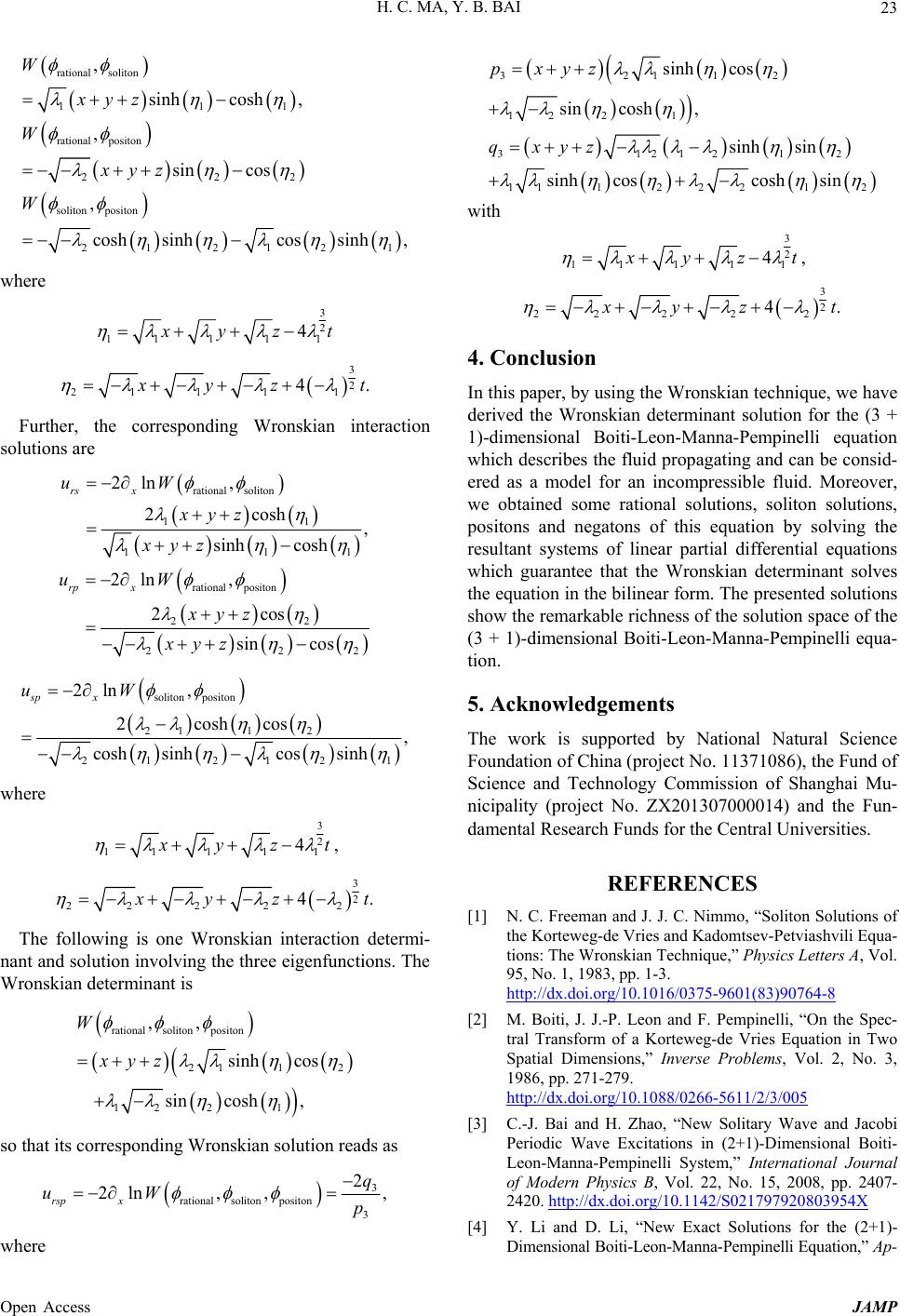 H. C. MA, Y. B. BAI 23 22 2 soliton positon 21 2121 sin cos , cosh sinhcossinh , xyz W rational soliton 111 rational positon , sinhcosh , , W xyz W where 3 2 1111 1 4 yzt 3 2 21 1 11 4. yz t Further, the corresponding Wronskian interaction solutions are rational soliton 11 11 2ln, 2cosh , 1 osh rs x uW xyz x sinh cyz rational positon 22 2ln , 2cos rp x uW xyz xyz 22 2 sin cos soliton positon 2112 21 212 2ln , 2coshcos, cosh sinhcossinh sp x uW 1 where 3 2 1111 1 4 yzt , 3 2 22 222 4. yz t The following is one Wronskian interaction determi- nant and solution involving the three eigenfunctions. The Wronskian determinant is rational solitonpositon ,,W xy 21 1 2 12 21 sinh cos sin cosh, z so that its corresponding Wronskian solution reads as 3 rational soliton positon3 2 2ln,,, rsp x q uW p 32112 12 21 312121 11122212 sinh cos sin cosh, sinh sin sinh coscoshsin pxyz qxyz 2 with 3 2 1111 1 4 yzt , where 3 2 22 222 4. yzt 4. Conclusion In this paper, by using the Wronskian technique, we have derived the Wronskian determinant solution for the (3 + 1)-dimensional Boiti-Leon-Manna-Pempinelli equation which describes the fluid propagating and can be consid- ered as a model for an incompressible fluid. Moreover, we obtained some rational solutions, soliton solutions, the resultant systems of linear partial differential equations which guarantee that the Wronskian determinant solves the equation in the bilinear form. The presented solutions remarkable richness of the solution space of the ensional Boiti-Leon-Manna-Pempinelli equa- tion. 5. Acknowledgements The work is supported by National Natural Science Foundation of China (project No. 11371086), the Fund of Science and Technology Commission of Shanghai Mu- ty (project No. ZX201307000014) and the Fun- damental Research Funds for the Central Universities. REFERENCES [1] N. C. Freeman and J. J. C. Nimmo, “Soliton Solutions of e Vries and Kadomtsev-Petviashvili Equa- nskian Technique,” Physics Letters A, Vol. positons and negatons of this equation by solving show the (3 + 1)-dim nicipali the Korteweg-d tions: The Wro 95, No. 1, 1983, pp. 1-3. http://dx.doi.org/10.1016/0375-9601(83)90764-8 [2] M. Boiti, J. J.-P. Leon and F. Pempinelli, “On the Spec- tral Transform of a Korteweg-de Vries Equation in Two Spatial Dimensions,” Inverse Problems, Vol. 2, No. 3, 1986, pp. 271-279. http://dx.doi.org/10.1088/0266-5611/2/3/005 [3] C.-J. Bai and H. Zhao, “New Solitary Wave and Jacobi Periodic Wave Excitations in (2+1)-Dimensional Boiti- Leon-Manna-Pempinelli System,” International Journal of Modern Physics B, Vol. 22, No. 15, 2008, pp. 2407- 2420. http://dx.doi.org/10.1142/S021797920803954X [4] Y. Li and D. Li, “New Exact Solutions for the (2+1)- Dimensional Boiti-Leon-Manna-Pempinelli Equation,” Ap- Open Access JAMP 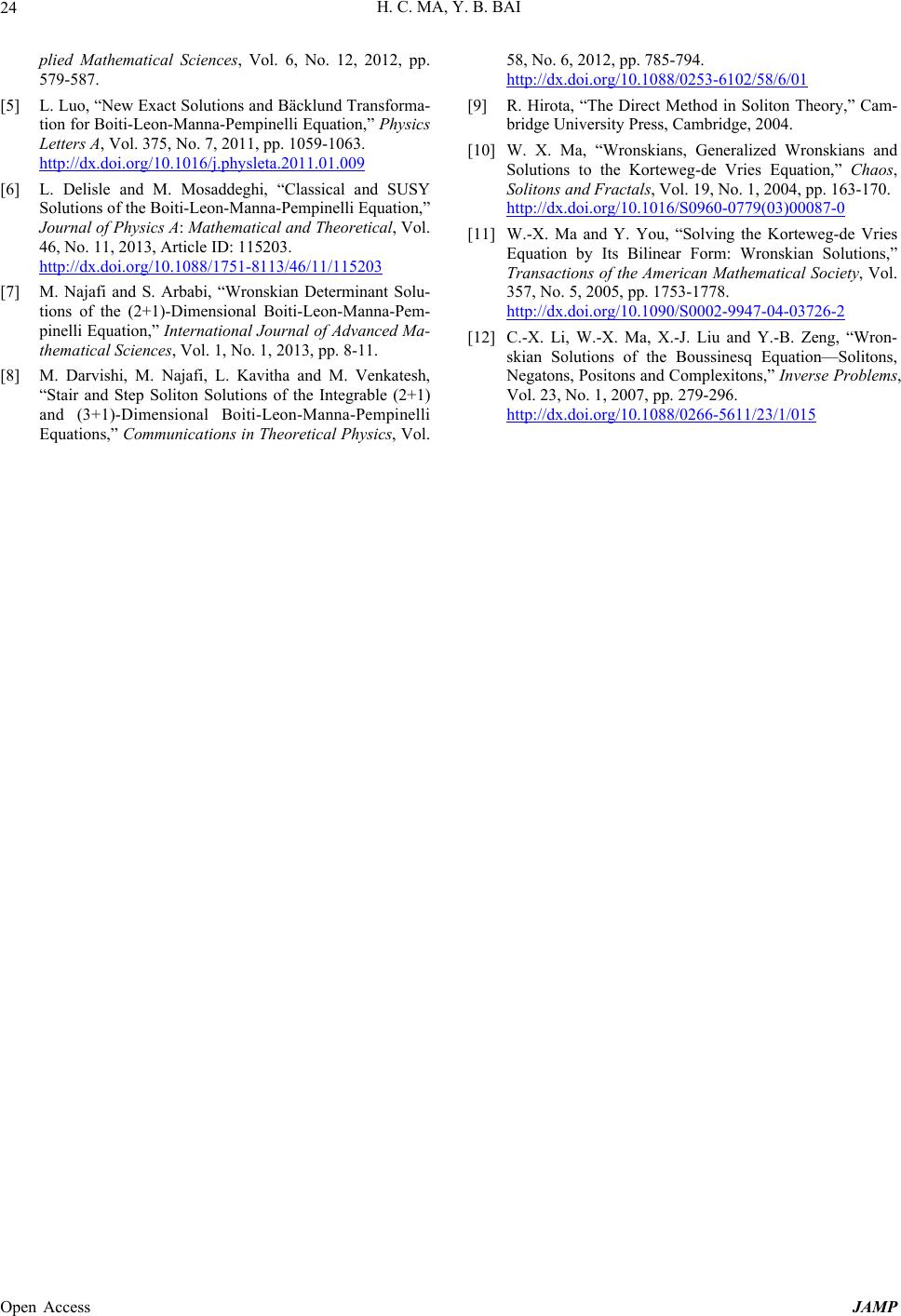 H. C. MA, Y. B. BAI Open Access JAMP 24 es, Vol. 6, No. 12, 2012, pp. plied Mathematical Scienc 579-587. [5] L. Luo, “New Exact Solutions and Bäcklund Transforma- tion for Boiti-Leon-Manna-Pempinelli Equation,” Physics Letters A, Vol. 375, No. 7, 2011, pp. 1059-1063. http://dx.doi.org/10.1016/j.physleta.2011.01.009 [6] L. Delisle and M. Mosaddeghi, “Classical and SUSY Solutions of the Boiti-Leon-Manna-Pempinelli Equation,” Journal of Phyd Theoretical, Vol. 46, No. 11, 20 sics A: Mathematical an 13, Article ID: 115203. http://dx.doi.org/10.1088/1751-8113/46/11/115203 [7] M. Najafi and S. Arbabi, “Wronskian Determinant Solu- tions of the (2+1)-Dimensional Boiti-Leon-Manna-Pem- pinelli Equation,” Internati thematical Sciences, Vol. 1, No. 1, 2013, pp. 8-11. onal Journal of Advanced Ma- ications in Theoretical Physics [8] M. Darvishi, M. Najafi, L. Kavitha and M. Venkatesh, “Stair and Step Soliton Solutions of the Integrable (2+1) and (3+1)-Dimensional Boiti-Leon-Manna-Pempinelli Equations,” Commun , Vol. 58, No. 6, 2012, pp. 785-794. http://dx.doi.org/10.1088/0253-6102/58/6/01 [9] R. Hirota, “The Direct Method in Soliton Theory,” Cam- bridge University Press, Cambridge, 2004. [10] W. X. Ma, “Wronskians, Generalized Wronskians and Solutions to the Korteweg-de Vries Equation,” C haos, Solitons and Fractals, Vol. 19, No. 1, 2004, pp. 163-170. http://dx.doi.org/10.1016/S0960-0779(03)00087-0 [11] W.-X. Ma and Y. You, “Solving the Korteweg-de Vries Equation by Its Bilinear Form: Wronskian Solutions,” Transactions of the American Mathematical Society, Vol. 357, No. 5, 2005, pp. 1753-1778. http://dx.doi.org/10.1090/S0002-9947-04-03726-2 [12] C.-X. Li, W.-X. Ma, X.-J. Liu and Y.-B. Zeng, “Wron- skian Solutions of the Boussinesq Equatio Negatons, Positons and Complexitons,” Invern—Solitons, se Problems, 5 Vol. 23, No. 1, 2007, pp. 279-296. http://dx.doi.org/10.1088/0266-5611/23/1/01
|